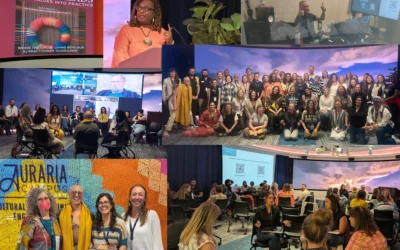CCRJP Members Create Harm Response Guidance
This readership likely understands the complexity and delicate tone at play as new groups, such as CCRJP, form a community. Vibrant with different experiences, personalities, gifts, and identities, CCRJP is working towards the fulfillment of our common goals to advance restorative practices while rooted together by many shared values. Yet, the spaces in between are often messy.
Our coalition of peace-builders who are familiar with the “messy middle” of conflict can experience friction ourselves. As we know, conflict can be productive, healthy, and generative. Conflict can also be destructive and counter-productive. What does it look like to pursue positive outcomes when we encounter conflict amongst ourselves?
“These are the types of questions and dilemmas that led CCRJP to create our Harm Process Guidance.”

Questions Come Up When Harm Occurs
CCRJP has already been witness to the “messiness’’ of community-building and the ways that coming together can sometimes lead to conflicting dynamics. Questions have come up like who should deal with the conflict? How do we work through harm? What if some people find an action harmful and others do not? How do we deal with conflict in large Zoom meetings? These are the types of questions and dilemmas that led CCRJP to create our Harm Process Guidance.
Ames Stenson, CCRJP President, played a large part in finalizing the guidance. Stenson reflects on the process here:
Creating CCRJP’s harm response process was an essential part of our organizational development. As we know as RJ/RP practitioners, anytime we are working with other people the possibilities of harm exist. We, CCRJP members, are not immune to this. Although we had some general ideas of how we might respond to harm as an organization, this process allows us, as a collective, to re-name our values and put our work into action when implicit or explicit harm occurs within CCRJP group settings and/or between members or partner organizations. It’s one thing to respond to harm from a personal perspective. However, we had to ask, how can CCRJP respond to harm in ways that honor and reflect our RJ/RP values (5Rs, power with, etc.) and practices, meet needs, encourage empowerment and personal accountability and support healing? How does the Board incorporate the diversity of member feedback into the process? I’m incredibly grateful that Cristina took the many notes from our board conversations along with the member brainstorming notes and created such an approachable, digestible process for us to utilize and grow into. I’m grateful to be a part of an organization that prioritizes the 5Rs in very real, applicable ways and I think we should be proud of our work. Personally, I have learned a lot from this process and look forward to implementing it and growing together.
Incorporating feedback from CCRJP members, the board worked to create guidance that responded to the needs of many. The guidance is a product of intentional listening and collaboration, bound by core restorative principles.
The Process Starts with a Commitment to Shared Principles
CCRJP has identified 6 principles that represent the core spirit of what restorative work can look like:
- Respect
- Inclusivity
- Openness
- Curiosity
- Compassion
- Humanity
While this list is not representative of the many values our coalition brings to the table, the values themselves leave room for various voices and approaches to the work. With these foundational principles as our starting place, our coalition can cultivate a shared and co-created space. This space is dynamic and ever-evolving – it grows and changes alongside the members, partners, and community. And yet, these principles bind us together and root us.
Beverly Title’s 5 R’s Remind Us of Our Actionable Commitments
The Guidance was also influenced by Beverly Title’s 5 R’s (Relationship, Respect, Responsibility, Repair, & Reintegration), a restorative foundation many RJ practitioners have learned from. When thinking about how the 5 R’s can help in times of conflict, the individuals working to create the guidance decided to make these actionable commitments:
- Tend Relationships
- Cultivate Respect
- Show Up Responsibly
- Turn to Repair
- Support Reintegration
The Harm Process Guidance offers support for navigating harm and conflict as it comes up in large coalition gatherings as well as incidents that happen outside of group settings. In the spirit of restorative responses, the guidelines attempt to offer solutions navigated with shared power amongst people involved.
We hope you will utilize these guidelines as a CCRJP Member and supporter. Should questions or concerns come up, please lean on the first “R” – relationship – and reach out!
Check Out More Great Articles
PROGRAM SPOTLIGHT: A Conversation with the Englewood Municipal Court Restorative Justice Program
Program Spotlight CCRJP: Will you tell us a little bit about the EMC-RJ Program EMC-RJ: The EMC-RJ Program was birthed in the summer of 2021 after a...
Weaving the Circle: Reflections from the 2025 CCRJP Statewide Convening
Program Spotlight On September 18th, 2025, about 130 restorative justice practitioners, advocates, and community partners from across Colorado...
Living the Work: Colorado’s Restorative Justice Guidelines in Action
Program Spotlight Whatever your connection to restorative justice—whether you’re an experienced facilitator, a new practitioner, or just...


